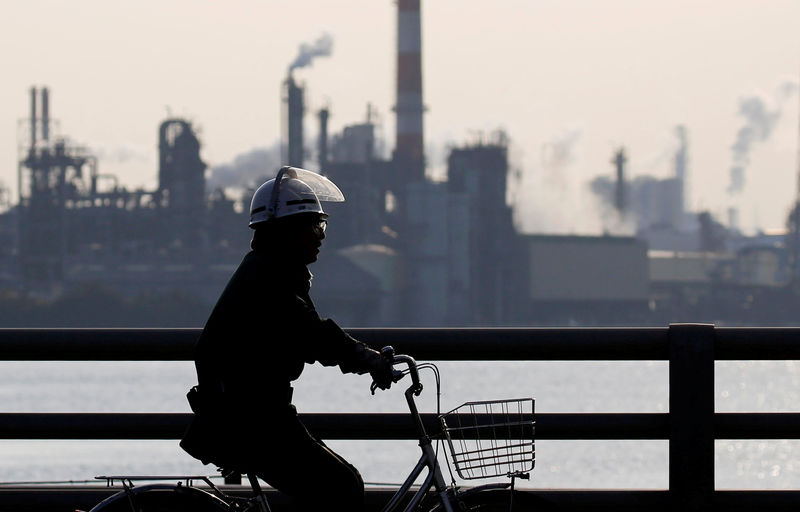 © Reuters. FILE PHOTO: A worker cycles near a factory at the Keihin industrial zone in Kawasaki, Japan
© Reuters. FILE PHOTO: A worker cycles near a factory at the Keihin industrial zone in Kawasaki, JapanBy Stanley White
TOKYO (Reuters) – Japan’s industrial output rose in August for the first time in four months as some factories resumed activity following heavy rain and floods, but uncertainty over the likely result of trade talks between Japan and the United States clouds the outlook.
Trade ministry data out on Friday showed factory output rose 0.7 percent in August from the previous month, less than economists’ median estimate of a 1.5 percent rise and following 0.2 percent decline in the previous month.
Manufacturers surveyed by the trade ministry expect output to rise 2.7 percent in September and 1.7 percent in October.
Industrial output should continue to grow in the future as demand for Japanese goods remains firm both domestically and overseas, but the chance that Japan will shift more auto production to the United States is a downside risk for output.
Output rose in August due to a 5.2 percent increase in auto production and a 5.6 percent increase in production of gear used to make semiconductors and flat-panel displays, the data showed.
The unemployment rate fell to 2.4 percent in August from 2.5 percent in the previous month, while the jobs-to-applicants ratio held steady at 1.63 jobs per applicant from, the highest level since January 1974, separate data showed.
Despite the solid economy and tight labor market, inflation is struggling to accelerate.
Tokyo’s core consumer price index (CPI), which includes oil products but excludes fresh food prices, rose 1.0 percent in the year to September, versus a 0.9 percent rise expected by economists and less than half the central bank’s 2 percent target.
The Tokyo index is available a month before nationwide core CPI, and serves as a leading indicator of consumer inflation.
Japanese retail sales rose 2.7 percent in August from a year earlier, compared with a median market forecast for a 2.1 percent increase, separate data showed on Friday.
U.S. President Donald Trump and Japanese Prime Minister Shinzo Abe agreed this week to start trade talks in an arrangement that, for now, protects Japanese automakers from further tariffs, seen as a major threat to the export-dependent economy.
Still, there are lingering concerns that Japan will have to dramatically lower auto exports to the U.S. market and greatly increase the number of cars in makes in the United States to meet Trump’s goal of creating more jobs and lowering the U.S. trade deficit.
Fusion Media or anyone involved with Fusion Media will not accept any liability for loss or damage as a result of reliance on the information including data, quotes, charts and buy/sell signals contained within this website. Please be fully informed regarding the risks and costs associated with trading the financial markets, it is one of the riskiest investment forms possible.
Source: Investing.com



























